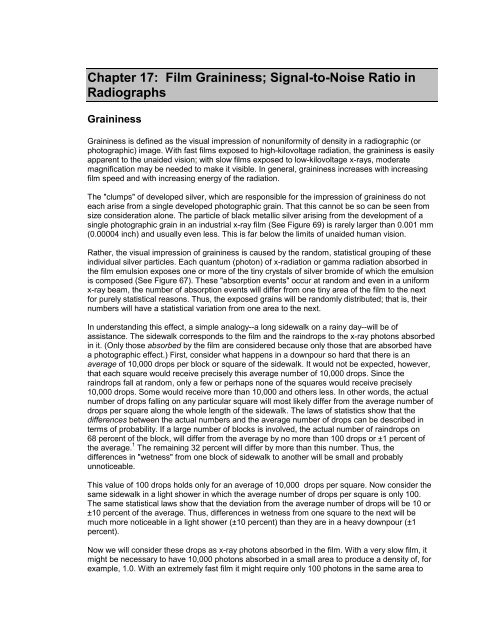Radiography in Modern Industry - Kodak
Radiography in Modern Industry - Kodak
Radiography in Modern Industry - Kodak
You also want an ePaper? Increase the reach of your titles
YUMPU automatically turns print PDFs into web optimized ePapers that Google loves.
Chapter 17: Film Gra<strong>in</strong><strong>in</strong>ess; Signal-to-Noise Ratio <strong>in</strong>RadiographsGra<strong>in</strong><strong>in</strong>essGra<strong>in</strong><strong>in</strong>ess is def<strong>in</strong>ed as the visual impression of nonuniformity of density <strong>in</strong> a radiographic (orphotographic) image. With fast films exposed to high-kilovoltage radiation, the gra<strong>in</strong><strong>in</strong>ess is easilyapparent to the unaided vision; with slow films exposed to low-kilovoltage x-rays, moderatemagnification may be needed to make it visible. In general, gra<strong>in</strong><strong>in</strong>ess <strong>in</strong>creases with <strong>in</strong>creas<strong>in</strong>gfilm speed and with <strong>in</strong>creas<strong>in</strong>g energy of the radiation.The "clumps" of developed silver, which are responsible for the impression of gra<strong>in</strong><strong>in</strong>ess do noteach arise from a s<strong>in</strong>gle developed photographic gra<strong>in</strong>. That this cannot be so can be seen fromsize consideration alone. The particle of black metallic silver aris<strong>in</strong>g from the development of as<strong>in</strong>gle photographic gra<strong>in</strong> <strong>in</strong> an <strong>in</strong>dustrial x-ray film (See Figure 69) is rarely larger than 0.001 mm(0.00004 <strong>in</strong>ch) and usually even less. This is far below the limits of unaided human vision.Rather, the visual impression of gra<strong>in</strong><strong>in</strong>ess is caused by the random, statistical group<strong>in</strong>g of these<strong>in</strong>dividual silver particles. Each quantum (photon) of x-radiation or gamma radiation absorbed <strong>in</strong>the film emulsion exposes one or more of the t<strong>in</strong>y crystals of silver bromide of which the emulsionis composed (See Figure 67). These "absorption events" occur at random and even <strong>in</strong> a uniformx-ray beam, the number of absorption events will differ from one t<strong>in</strong>y area of the film to the nextfor purely statistical reasons. Thus, the exposed gra<strong>in</strong>s will be randomly distributed; that is, theirnumbers will have a statistical variation from one area to the next.In understand<strong>in</strong>g this effect, a simple analogy--a long sidewalk on a ra<strong>in</strong>y day--will be ofassistance. The sidewalk corresponds to the film and the ra<strong>in</strong>drops to the x-ray photons absorbed<strong>in</strong> it. (Only those absorbed by the film are considered because only those that are absorbed havea photographic effect.) First, consider what happens <strong>in</strong> a downpour so hard that there is anaverage of 10,000 drops per block or square of the sidewalk. It would not be expected, however,that each square would receive precisely this average number of 10,000 drops. S<strong>in</strong>ce thera<strong>in</strong>drops fall at random, only a few or perhaps none of the squares would receive precisely10,000 drops. Some would receive more than 10,000 and others less. In other words, the actualnumber of drops fall<strong>in</strong>g on any particular square will most likely differ from the average number ofdrops per square along the whole length of the sidewalk. The laws of statistics show that thedifferences between the actual numbers and the average number of drops can be described <strong>in</strong>terms of probability. If a large number of blocks is <strong>in</strong>volved, the actual number of ra<strong>in</strong>drops on68 percent of the block, will differ from the average by no more than 100 drops or ±1 percent ofthe average. 1 The rema<strong>in</strong><strong>in</strong>g 32 percent will differ by more than this number. Thus, thedifferences <strong>in</strong> "wetness" from one block of sidewalk to another will be small and probablyunnoticeable.This value of 100 drops holds only for an average of 10,000 drops per square. Now consider thesame sidewalk <strong>in</strong> a light shower <strong>in</strong> which the average number of drops per square is only 100.The same statistical laws show that the deviation from the average number of drops will be 10 or±10 percent of the average. Thus, differences <strong>in</strong> wetness from one square to the next will bemuch more noticeable <strong>in</strong> a light shower (±10 percent) than they are <strong>in</strong> a heavy downpour (±1percent).Now we will consider these drops as x-ray photons absorbed <strong>in</strong> the film. With a very slow film, itmight be necessary to have 10,000 photons absorbed <strong>in</strong> a small area to produce a density of, forexample, 1.0. With an extremely fast film it might require only 100 photons <strong>in</strong> the same area to
















